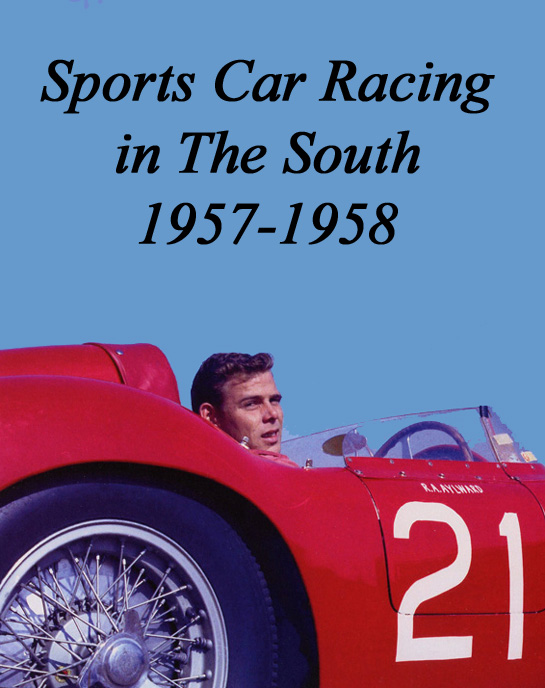
Bobby Aylward was the adopted son of Kansas oilman Joe Aylward. In addition to being a very aggressive and competitive driver, Bobby loved guns and Wichita bars. Seated in his 250S Maserati, Aylward looks over his shoulder at photographer Bob Jackson at an SCCA regional at Oklahoma in 1958.
Review By Pete Vack
All photos by Bob Jackson and courtesy Willem Oosthoek
Want a copy? Just email Willem Oosthoek at willemoosthoek@aol.com and he’ll personally take care of your order!
Sportscar racing in The South, Texas to Florida, 1957-1958, by Willem Oosthoek: Two years, 57 reports of airport races in eight states, 343 black and white photos, 121 in color, packed in a large slim hard back of 264 pages. On the surface, that’s what you get for your $125 USD. But do some scratching and you will be relieved to find more to it than mere results.
Unlike Terry O’Neil’s excellent and more substantial book “Northeast American Sports Car Races”, (read review) author Willem Oosthoek was able to make use of a considerable amount of information provided via personal interviews with many of the participants of the events covered (he lists 25, many whom passed on before the book was finished). With access to many of the original players, Oosthoek gives the story a human side rarely if ever seen in print—certainly not in Road & Track, not in the SCCA Sports Car, not in Competition Press, and rarely in the local papers. Ostensibly a much needed record of the sports car racing scene from Texas to Florida, throughout the book between the stats and photos, are nuggets of personal information which brings these years alive.
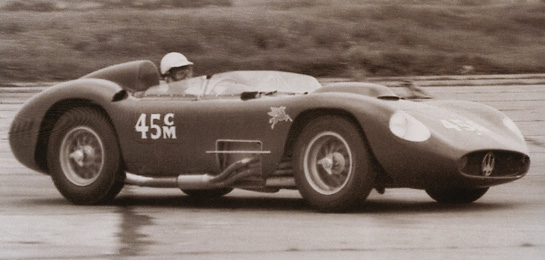
Galveston Island, April 19-20 1958. Ebb Rose in the 450S, chassis 4509, purchased from CSSCI. His main competition was E.D. Martin in the Ferrari 315S. Rose won both features.
Scratch a bit and you’ll find that Carroll Shelby, the front man for Dick Hall’s CSSCI Carroll Shelby Sports Cars Inc., sold a 450S to Jesse “Ebb” Rose. In a coffee shop at Love Field near Dallas, Rose met Shelby to complete the deal on a new Maserati 450S. According to Oosthoek’s sources, “He [Rose] paid cash for his latest fleet addition and while the documents were sorted out, laid his Colt 45 atop a stack of bills totaling $12,000. The responsibility of depositing the money at Republic Band the next day was given to Hall rather than Shelby.” Shelby may not have been a great businessman but conversely Dick Hall was no Shelby when it came to driving. Hall was, however, the joint owner of Condor Petroleum and older brother of Jim Hall, who did eventually become a driver on the same level as the charming Shelby.
Although a lot of the racing in the South was fueled with Texas oil money, Oosthoek finds all sorts in the drivers’ seat. Dick McGuire, Harry Rollings and David Lane were in the medical field, E.D. Martin owned a chain of theaters, A.D. Logan supplied Safeway with fruits and veggies, Bill Fuller was in the lumber business. Ebb Rose with the $12,000 cash and Colt ran a trucking business. This was a cross section of America in 1957 and 58; all powerful, omnipotent, and above all else, wealthier than any other country at any other time in history.
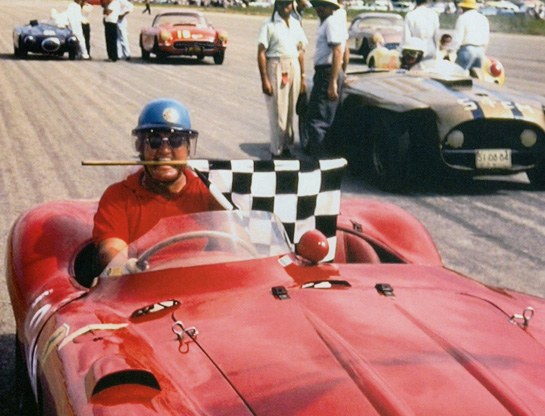
Texas rancher Roy Cherryhomes owned a fleet of OSCAs and Ferraris and employed Shelby to drive for him. But here he is at the wheel of his Ferrari 121LM, chassis 0558 after winning an event in Mansfield LA in 1956.
What this also meant is that although the events that took place at these admittedly far away outposts of America were minor (so minor that many results were not published anywhere by anyone!), the cars were the finest that money could buy. E.D. Martin started with a Ferrari 760 Monza, then a 857 Monza, and graduated to the biggest and fastest Ferrari available, the four cam 3.8 liter 315s designed specifically to eradicate the threat of the Maserati 450S. Why these ultimate machines designed for high falutin’ locales like the Mille Miglia, (where glamorous film star Linda Christian gave Spanish nobleman Fon Portago his last kiss before he crashed his Ferrari 315s and ended his life and the race itself) Le Mans, and the Nurburgring ended up racing at an obscure airport in Hammond, Lousiana, is a good question and one of the true ironies of the times. Of course the purchase of the 315 S by Martin gave guys like Ebb Rose reason to hand over wads of cash to CSSCI for cars like the 450S.
According to Oosthoek, one of the main reasons the big ones hit the U.S. (not that the 2 and 3 liter Maserati and Ferraris were doing badly) was the decision by the FIA to put a limit of three liters for the 1958 season. The the monsters built in 1957—in particular the 315S and 450S Maserati—were now free to be brought into the U.S. by small businesses such as Hall’s CSSCI, which became a Maserati distributor. It was a rare Southern event that did not feature a 200S, 300 or 450S Maserati on the grid and most likely on the podium. CSSCI also sold British cars as their bread and butter, but as many before had found out, racing is expensive.
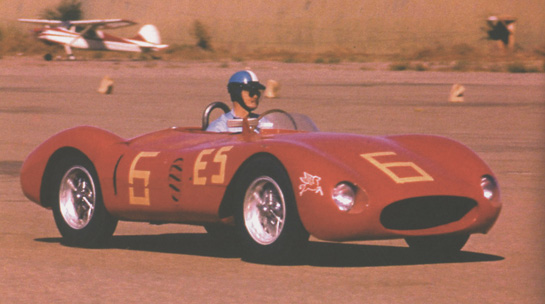
A rare shot of the Maserati A6G-2000 taken at Fort Sumner NM in September 1957. Owned by Bobby Burns, the car was damaged in a tornado and mechanic George Brand built this special body for the aging Maserati.
This predominance of the Maserati marque at these airport venues meant that eventually, and thankfully, Oosthoek would begin to scrutinize the era. Oosthoek is a man on a mission of accuracy, hunting results like a mad CPA tracking down the last penny on a huge account. A retired banker, he has a desire to see that the cars he has chronicled—in particular the 450 S and Birdcage Maseratis—are given their just due. (Purchase both of Oosthoek’s Birdcage books here at a special price) At the same time, he is particularly hard on historians and car owners who claim victories their cars never won. In fact, it was this search for the truth that was the prime motivator for the creation of this book. It became a quest for information, most of which has been badly neglected in terms of the sports car racing scene from Texas to Florida in the mid fifties. The lack of factual information about these events—they were rarely covered in newspapers, auto magazines or in many cases, not even the SCCA club magazine, created a vacuum that could be filled with pure speculation posing as historical fact. According to Oosthoek, “As a result, in recent years much disinformation has been published with sometimes perplexing claims about who won which Southern event in what car. A case in point is a superficially researched article that appeared in the October 1974 issue of Motorsport regarding Frank Harrison’s Maserati 450s, chassis 4510, and its competition history on southern tracks. Over time it led to ludicrous claims that have spread on the Internet about the car’s victories and race appearances, most of which never took place.”
Things like that really get to a fastidious historian. While in the larger order of things, it matters very little who won an obscure airport event in Alabama over a half century ago, when cars cease being mere race cars but cultural art artifacts worth millions of dollars, the value of the provenance rises to the occasion. Thus, the Willem Oosthoeks of this world play an important role in establishing said history.
Oosthoek being Oosthoek, along with the backing and of Glyn Morris at Dalton Watson, created a superb series of indexes to accentuate his research and at the same time made this book one valuable reference source. In addition to identifying major cars by serial number in the text and in the captions, after each year he lists “Indentified Sportsracers Campaigned by Privateers around the South” and includes Ferrari and Maseratis with chassis number, model, owner and driver. Then source material and a map of the U.S. with locations of each event covered. Next, an index by car–and by model: a Ferrari 625LM appears on page 123. After this, an index of car chassis: Ferrari 750 Monza, chassis number 0518 appears on pages 68, 71, and 106. There is an index for Media; the Palm Beach Post was quoted on page 22 and 252. Another index lists “Other” and yet another lists “People”. Can I tell you the number of ways I love this book?
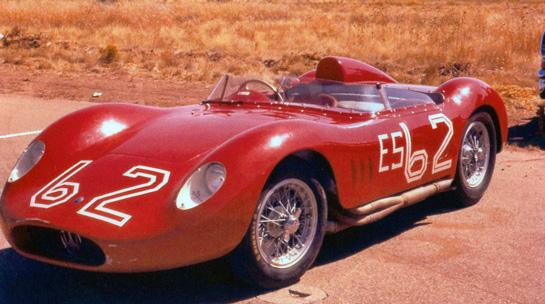
The improved handling of the Maserati 200SI—still a favorite among vintage racers—meant that many overall victories were achieved by the car which had a new de Dion rear end. This is chassis 2426 as raced by Jim Hall.
Readers must be advised, however, that the race reports do not provide a full result schedule (in boxes) for the production classes. Oosthoek explains: “The text covers all individual races with their overall and class winners from Novice Races to the Feature. However, rather than include the individual results schedules for each and every weekend race, often with unknown amateurs at the wheel of production cars, the decision was made to reserve the schedules for the modified races.” He adds that the information on production classes was even sparser than the modifieds. In other words, we are lucky to have what we have. Fortunately, another book is planned, which will cover the years 1959-1960.
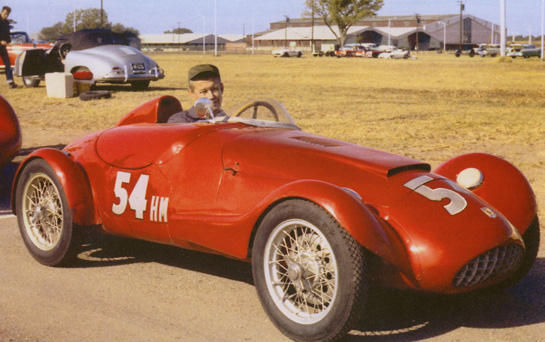
Oosthoek doesn’t forget about the small modifieds like this Bandini driven by Bob Samuelson at Oklahoma City in November, 1958.
A significant contribution to the book came from Pulitzer Prize-winning photographer Bob Jackson. (Jackson took the photo of Jack Ruby shooting Lee Harvey Oswald). Jackson went to college only a few blocks from the CSSCI Dallas location and naturally got involved in the sport. He became a professional photographer and retired in 1999. Jackson’s photos comprise a large percentage of the color and black and white shots in Oosthoek’s book. Unfortunately, aside from photo credits in the captions, there is little mention of Jackson in the book itself; his short bio is on the flap of the book cover only.
Another major contributor was Bob Schroeder, who not only won feature races with his own Kurtis 500X/Buick but wrenched for CSSCI, also loaned a great many photos from his collection.
Oosthoek didn’t stop there however, gathering many great color shots from the era, again, never seen before in any publication. This did not come cheap; he had to personally pay for many of the photos which appear in the book, and is still upside down with this one. In order to help defray these expenses, Oosthoek is selling a limited number of copies himself, and autographing those sold in the U.S. To order, deal with him directly at willemoosthoek@aol.com.
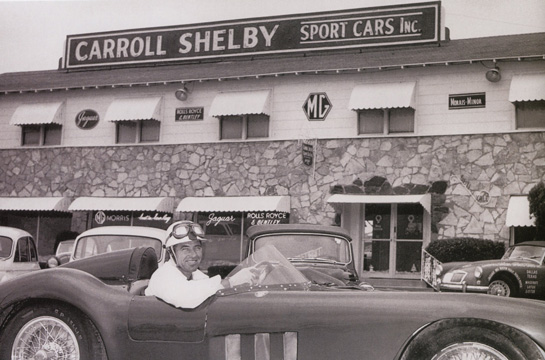
Shelby in Maserati 300S, chassis 3052, which was traded in by Jack Hinkle at CSSCI. In the background are a few of the British cars sold by the dealership, which failed to keep up with the expenses of racing Maseratis.
The book’s unpublished photography, anecdotes and little nuggets go right to the end. By the end of the 1958 season, Shelby, who was no businessman but one hell of a driver, had signed with Aston Martin; the Lister Jag and Chevies were now the hot numbers and CSSCI was at the end of its financial rope. The sales of British cars never supported the cost of racing Italian ones. The IRS figured that “if all the cars produced in England were sold by CSSCI, they would still be unable to turn a profit.” But it was a good time while it lasted.
Want a copy? Just email Willem Oosthoek at willemoosthoek@aol.com and he’ll personally take care of your order!
Ferrari 250 GBT4 1962
ferrari 250 GTO 1962
What a great book. Congratulations, Mr.Oosthoek!
I reviewed Willem’s book for Prancing Horse magazine. I began the review with, “If I was texting this I would begin with OMG. This book is that good!” And it really is! I was familiar with many of the drivers and cars in the book, because I began to prowl the SCCA Central Florida Region races as a teenager beginning in 1959. Willem’s careful and tenacious research has produced a book that fills a black hole about sport car racing in the southern states in the 1950s and 1960s, as sports car racing in the Northeast and West Coast has gotten the most press in the past.
Thank you Mr Oosthoek. Your level of research and attention to detail is greatly admired.
I have all three reditions of RACING IN THE SOUTHWEST by Wilhelm Oosthoek having contrbuted material for all three books. I crewed for Bobby Aylward (Lotus 11 & 250SI Maserati) and Delmo Johnson (Corvettes &Chevvy powered Jaguar XK-SS) I was a minor part of the scene and was well acquainted with Bob Jackson. Got in touch with Wilhelm when I took exception to his statement that Bobby Aylward was known as a “rounder” in Wichita. I was able to fill in some informational gaps.Note:Bobby was always a perfect gentleman when we were at the races and never could be called a “dirty driver” tho he did have the opportunity on more than one occasion. Nuff Said